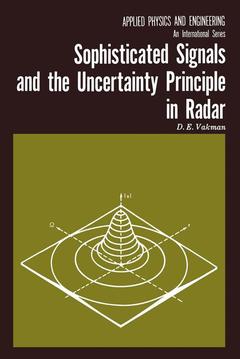Sophisticated Signals and the Uncertainty Principle in Radar, Softcover reprint of the original 1st ed. 1968 Applied Physics and Engineering Series, Vol. 4
Langue : Anglais
Auteur : Vakmann D.E.
Coordonnateur : Jacobs E.

This book is devoted to some of the problems encountered in the theory of sophisticated signals used in radar. The term sophisticated signal is under stood to mean a signal for which the product of the signal duration by the spectrum width substantially exceeds unity. Although it is impossible to draw an exact borderline between simple and sophisticated signals, the term "sophisticated signal" is sufficient to define one of the principal characteristics of modern radar. Recently, various sophisticated signals (frequency-modulated pulses, coded groups, phase-modulated signals, etc.) have found use in radar. This makes it possible to improve the resolution, to ensure simultaneous measurements of the range and range rate of a target, to elecrically scan over finite angular dimensions, etc. Although the realization of such potentialities is associated with substantial difficulties, one can say with certainty that "classical" radar technology, which uses simple signals at constant frequency and duty cycle, yields to more complex methods based on the use of wide-band signals of the sophisticated structure. The properties of radar signals, which characterize the measurement of a target's range and range rate, are described by the Woodward ambiguity function. The role of this function is similar to that of the antenna pattern, i.e., the ambiguity function defines the accuracy and resolution of the range and range rate measurements to the same extent as the antenna pattern de fines the accuracy and resolution of the azimuth and elevation measurements.
1. Pulse Compression Signals.- [1] Optimal Reception of Signals-Matched Filter.- [2] Response of a Pulsed Signal to a Matched Filter-Correlation Method.- [3] Optimal Reception of Frequency-Modulated Pulse Signals.- [4] Compression Ratio.- [5] Spectrum Compression.- [6] Admissible Errors in the Frequency — (Phase-) Modulation Law for Systems with Pulse Compression.- [7] Formation of Sophisticated Signals.- 2. The Uncertainty Principle.- [8] The Woodward Ambiguity Function.- [9] Examples.- [10] Some Properties of Ambiguity Functions—The Radar Uncertainty Principle.- [11] Analogy with Quantum Physics.- [12] Uncertainty Principle of Quantum Physics.- [13] Other Forms of the Uncertainty Relationship.- [14] Resolution and Selectivity of a Linear Measuring Device.- [15] Resolution of Spectral Analysis.- [16] Measurement of Instantaneous Frequency.- [17] The Generalized Ambieuitv Function.- 3. The Ambiguity Function in the Statistical Theory of Radar.- [18] Sampling Space.- [19] Principle of Maximum Likelihood.- [20] The Ambiguity Function in Relation to Resolution.- [21] The Ambiguity Function in Relation to the Measured Parameters.- [22] Radar Observations and Measurements in Relation to General Physics.- 4. Synthesis of Signals Using Ambiguity Functions.- [23] Some Remarks on Signal Synthesis.- [24] Classes of Signals and Autocorrelation Functions—Statement of the Synthesis Problem.- [25] Synthesis of the Autocorrelation Function from its Magnitude and Phase at Discrete Points.- [26] Synthesis of the Autocorrelation Function from its Magnitude.- [27] Optimal Autocorrelation Functions—Linear Approximation.- [28] Optimal Autocorrelation Functions—Quadratic Approximation.- [29] Synthesis of Autocorrelation Functions Given Over a Bounded Time Interval.- [30] Comparisonof Optimal Power Spectra.- [31] Synthesis of FM Signals from Given Power Spectra.- [32] Phase-Modulated Signals.- [33] Statistical Synthesis of PM Signals.- [34] Synthesis of FM Signals from Two Cross Sections of the Ambiguity Function.- [35] Rotation of the Ambiguity Function.- [36] FM Signals with Uniform Side Lobes in the t,?-Plane.- [37] Approximate Synthesis Method from the Magnitude and Phase of an Arbitrary Ambiguity Function.- [38] Generalization of Synthesis from the Magnitude of an Ambiguity Function.- Appendices.- Appendix 1. Spectra of Wide-Band FM Signals Approximated by the Stationary Phase Method.- Appendix 2. Calculation of Phase Measurement Errors.- Appendix 3. Estimate of Amplitude Distribution for a Signal with Random Initial Phase.- Appendix 4. Determination of the Dolph-Chebyshev Autocorrelation Function and the Corresponding Power Spectra.- Appendix 5. Spheroidal Functions.- References.- Author Index.
Date de parution : 01-1968
Date de parution : 04-2012
Ouvrage de 254 p.
15.2x22.9 cm
Thèmes de Sophisticated Signals and the Uncertainty Principle in Radar :
Mots-clés :
Signals; correlation; phase; physics; quantum physics; quantum theory; research; structure; technology; uncertainty; remote sensing/photogrammetry
© 2024 LAVOISIER S.A.S.



